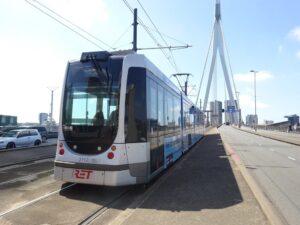
As the Dutch public transportation is one of the topics that makes the news headlines every few weeks due to strikes, increased fees, and other several issues, today’s article aims to analyse the efficiency of the public transport in the Randstad area and to compare it with other successful stories from European big cities.
Public transportation in Amsterdam, Rotterdam, and The Hague is facing significant financial challenges, with a budget reduction of €110 million starting in 2026. This decision, confirmed by the Ministry of Infrastructure and Water Management, reallocates funds from public transport to a general provincial and municipal fund, reducing administrative burdens. However, this reallocation includes a 10% cut, as stipulated in the coalition agreement of several political parties.
Previously, a budget of approximately €1.1 billion was allocated for the Amsterdam and Rotterdam-The Hague transport regions. Now, local governments must prepare for these changes, potentially impacting services as early as next year.
Concerns from Local Authorities
Leaders in the affected regions have expressed serious concerns about the implications of these cuts. Transport authorities warn that the reductions will disproportionately affect vulnerable groups, including students, parents, and low-income individuals who rely heavily on public transit.
Melanie van der Horst, chair of the Amsterdam Regional Transport Authority, highlighted that public transport is already unaffordable for many residents. She fears that further cuts and possible fare increases will restrict access to jobs, education, healthcare, and family connections, especially for suburban areas like Diemen, Purmerend, and Volendam.
Similarly, Jan van Zanen, chair of the Metropolitan Region Rotterdam – The Hague, emphasized that reliable public transport is critical for supporting the region’s planned construction of 400,000 new homes. He warned that these cuts could compromise accessibility, threatening the success of these housing developments.
Impacts on Service and Affordability
The reductions could result in fewer buses and other public transport options in the region, along with higher ticket prices and reduced service quality. Arjen Kapteijns, alderman for mobility in The Hague, criticized the cuts as counterproductive, arguing that public transport funding should not be treated as a general benefit subject to budget reductions.
Next Steps
In response to the planned reductions, the Amsterdam and Rotterdam-The Hague transport regions are urging the Dutch Parliament (Tweede Kamer) to reconsider. State Secretary Chris Jansen acknowledged the concerns and stated that discussions are ongoing to assess the potential impact of the measures. Furthermore, the Dutch authorities could follow the models of other European cities that have a high efficient public transport.
European cities as examples to follow
According to a report from 2023, Zurich, Switzerland, ranks highest in public transport satisfaction, with an impressive 95% of residents expressing their approval. Zurich’s success stems from significant investments in a well-integrated network of trams, buses, and trains, all renowned for their punctuality, cleanliness, and reliability.
Vienna, Austria, follows closely with 91% of residents satisfied with their public transport. The city’s system is celebrated for its affordability, comprehensive coverage, and efficiency, making it a standout among European capitals.
Helsinki, Finland, also performs well, with 89% of residents satisfied. The city’s modern, eco-friendly transport options, including buses, trams, and ferries, provide seamless access throughout the city and surrounding areas. This integrated system is especially valued for facilitating trips to nearby islands.
Stockholm, Sweden, earns an 88% satisfaction rate, reflecting its reliable, clean, and sustainable public transport. The city’s commitment to eco-conscious practices makes its transport options particularly appealing to environmentally minded commuters.
Recommendations based on the models of other European cities
- Invest in Punctuality and Reliability
- Focus on minimizing delays by upgrading infrastructure, introducing better scheduling systems, and employing advanced technologies for real-time monitoring and maintenance.
- Establish performance benchmarks to ensure buses, trams, and trains run on time consistently.
- Enhance Integration and Coverage
- Develop a seamless network connecting buses, trams, and trains, making transfers easy with unified ticketing and synchronized schedules.
- Expand services to underserved suburban areas to ensure all residents have convenient access to public transport.
- Prioritize Cleanliness and Comfort
- Maintain high cleanliness standards across vehicles and stations.
- Invest in modern, comfortable vehicles with adequate seating, climate control, and accessibility features.
- Focus on Extensive Accessibility
- Ensure all vehicles and stations are accessible to individuals with mobility challenges.
- Develop infrastructure to make public transit stations more user-friendly, including escalators, elevators, and clear signage.
- Promote Eco-Conscious and Community-Centered Initiatives
- Create incentives for eco-friendly commuting, such as discounts for frequent riders or rewards for using sustainable modes of transport.
- Engage with local communities to address specific transit needs and ensure widespread satisfaction.
- Integrate Urban Development with Transit Planning
- Design public transport systems that support urban development, ensuring new housing projects are accessible via reliable transit routes.
- Partner with urban planners to create transit-oriented developments, reducing the dependency on cars.
The aforementioned recommendations are indeed not aligned with the budget cuts, however, with a higher investment in the initial phase, there will be an improvement in time regarding the budget as new technologies and sustainable options will require less maintenance and are less prone to create high costs.
To conclude, by drawing inspiration from Zurich’s emphasis on punctuality and integration, Vienna’s affordability, Helsinki’s eco-friendly innovations, and Stockholm’s sustainability focus, the Dutch cities can adopt best practices tailored to their unique needs, enhancing public transportation systems and resident satisfaction.
References
Draghia, L. (2024, September 19). Zurich ranks highest for public transport satisfaction – how does your city compare? Retrieved from EuroWeekly: https://euroweeklynews.com/2024/09/19/zurich-ranks-highest-for-public-transport-satisfaction-how-does-your-city-compare/
NL Times. (2024, September 17). Cabinet to cut €110 million from budget for public transport in three major cities. Retrieved from NL Times: https://nltimes.nl/2024/09/17/cabinet-cut-eu110-million-budget-public-transport-three-major-cities
Photo:
https://live.staticflickr.com/4218/35499124655_d63d3033ba_b.jpg



